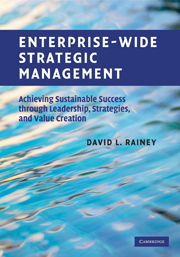 Enterprise-Wide Strategic Management
Enterprise-Wide Strategic Management from Part I - Context: Laying the foundation and the underpinnings of ESM
Published online by Cambridge University Press: 05 June 2012
Introduction
Strategic management is a high-level management construct that is well defined and understood by most executives, strategic leaders, strategists, practitioners, and business scholars. It initially focused on strategic leadership, business policies, and long-range planning. It evolved from the poorly articulated management constructs involving business policy during the 1950s and earlier to the more formal strategic management methodologies of the 1970s. Kenneth Andrews (1916–2005) of Harvard Business School and H. Igor Ansoff (1918–2002) of Massachusetts Institute of Technology were two of the renowned pioneers of strategic management and strategic business planning (SBP). Today, strategy management is one of the most well-known and frequently used constructs in business management. Andrews defined it thus:
Corporate strategy is the pattern of decisions in a company that determines and reveals its objectives, purposes, or goals, produces the principal policies and plans for achieving those goals, and defines the range of businesses the company is to pursue, the kind of economic and human organization it is or intends to be, and the nature of the economic and non-economic contribution it intends to make to its shareholders, employees, customers, and communities. In an organization of any size or diversity, “corporate strategy” usually applies to the whole enterprise while “business strategy,” less comprehensively defines the choices of product or service and market of individual businesses within the firm. Business strategy is the determination of how a company will compete in a given business and position itself among its competitors. Corporate strategy defines the businesses in which a company will compete, preferably in a way that focuses resources to convert distinctive competence into competitive advantages.
To save this book to your Kindle, first ensure no-reply@cambridge.org is added to your Approved Personal Document E-mail List under your Personal Document Settings on the Manage Your Content and Devices page of your Amazon account. Then enter the ‘name’ part of your Kindle email address below. Find out more about saving to your Kindle.
Note you can select to save to either the @free.kindle.com or @kindle.com variations. ‘@free.kindle.com’ emails are free but can only be saved to your device when it is connected to wi-fi. ‘@kindle.com’ emails can be delivered even when you are not connected to wi-fi, but note that service fees apply.
Find out more about the Kindle Personal Document Service.
To save content items to your account, please confirm that you agree to abide by our usage policies. If this is the first time you use this feature, you will be asked to authorise Cambridge Core to connect with your account. Find out more about saving content to Dropbox.
To save content items to your account, please confirm that you agree to abide by our usage policies. If this is the first time you use this feature, you will be asked to authorise Cambridge Core to connect with your account. Find out more about saving content to Google Drive.